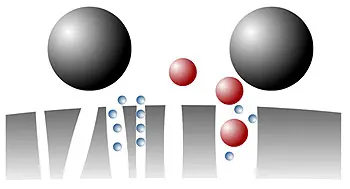- 3% Discount on online orders
- Fast Delivery Times
- DIN ISO 9001:2015 Certified
- Manufacturer Expertise
- Contact Us
Checkout using your account
Checkout as a new customer
Creating an account has many benefits:
- See order and shipping status
- Track order history
- Check out faster
Organic Size Exclusion Chromatography GPC/SEC
Organic gel permeation chromatography (GPC), also known as size exclusion chromatography (SEC) for organic solvents, is a chromatographic method in which polymers and other macromolecular compounds are separated by size and structure in an organic solvent. In contrast to aqueous SEC, where the analysis is performed in an aqueous medium, organic GPC utilises organic solvents as the mobile phase. This is particularly advantageous for analysing polymers that are insoluble in water but can be dissolved in organic solvents such as tetrahydrofuran (THF), chloroform or dimethylformamide (DMF). Organic GPC is essential for the characterisation of new polymers and the optimisation of polymerisation processes. It provides important insights into polymer chemistry and supports the development of materials with customised properties for applications in medicine, the packaging industry, electronics and many other areas.
Read the theoretical basics of GPC on this page and find tips on choosing the right GPC column as well as handling and application. As a manufacturer of GPC bulk materials and GPC columns, we are happy to support you with our manufacturing expertise.

Further categories of Size Exclusion Chromatography:
Products
Technical Data
Basics
GPC/SEC stationary phases
Polystyrene-dinvinylbenzene (PS-DVB) copolymers are usually used as stationary phases. These copolymers exhibit very low to no absorption of analytes and therefore do not require further functionalisation. For use with light scattering detectors, the polystyrene-dinvinylbenzene copolymer is often post-treated to reduce interfering peaks.
Mobile phases of GPC/SEC
In gel permeation chromatography (GPC), organic mobile phases are used that can dissolve non-polar polymers (plastics). Tetrahydrofuran (THF) is used as a standard solvent. Other solvents such as chloroform or dimethylformamide (DMF) can also be used. When changing the solvent, however, attention must be paid to the swelling behaviour of the PS-DVB polymers.
GPC/SEC detectors
In principle, the same detectors can be used for gel permeation chromatography as in HPLC. UV and RI detectors are particularly suitable. In order to obtain specific molecular and structural information about the analytes, light scattering and viscosity detectors are also used in polymer analysis. When SEC is combined with light scattering, viscometers and concentration detectors (known as triple detection), it can calculate absolute molecular weight, molecular size and intrinsic viscosity as well as provide information on macromolecular structure, conformation, aggregation and branching. Multi Angle Light Scattering Detectors (MALS) are available as a further development to light scattering. These MALS detectors can be used to directly determine the absolute molecular weight of a sample.
Reference materials for GPC/SEC
When using reference materials with known molecular size and molecular mass distribution, the GPC system can be calibrated to allow precise analysis of molecular weights and molecular size distribution in a sample. Calibration standards are essential to regularly check the performance of the GPC system and ensure that results are consistent and reliable over time. These standards also help to optimise separation conditions and improve analytical accuracy, making them a critical component of high quality GPC analysis. MZ-Analysentechnhik GmbH offers you a wide range of different SEC reference materials from manufacturers such as Sigma Aldrich, Tosoh, Shodex or Waters.
Columns for the SEC/GPC
To select a suitable column, a few basic questions should be clarified first.
1. what is the polarity of the analyte and which solvents are suitable?
Gel permeation chromatography (GPC) is suitable for non-polar polymers (plastics). Styrene-divinylbenzene copolymers (PS/DVB) usually serve as the stationary phase. For very polar biomolecules, such as proteins or antibodies, purely aqueous buffers are often used as eluents. Gel filtration chromatography is used to analyse these water-soluble polymers
2. what is the molecular weight of my analyte?
The molecular weight of the analyte or its size in the solvent determines the pore size of the stationary phase. The absolute pore sizes range from about 25 to 30,000 Å, covering a molecular weight range of about 100 to > 20,000,000 Daltons. For samples with very different molecular weights, either several columns with different pore sizes can be connected in series or columns containing particles with different pore sizes can be used. These are often labelled "linear", "mixed gel" or "multipore gel".
In many cases, suitable pore sizes can be easily determined with the help of the usually very extensive calibration data provided by the manufacturers.
Other manufacturers of GPC columns
Columns for organic mobile phases (GPC)
| Manufacturer | Column lines | Characteristics |
| MZ-Analysentechnik GmbH | Base material: PS/DVB | |
| MZ-Analysentechnik GmbH | MZ-SuperFG | Base material: silica gel |
| Shodex™ | K-800 Series | Base material: PS/DVB |
| Shodex™ | KF-600 Series | Base material: PS/DVB |
| Shodex™ | LF Series | Base material: PS/DVB |
| Shodex™ | HT and UT Series | For high temperature applications up to 210 °C |
| Shodex™ | HFIP Series | For HFIP as eluent |
| Tosoh Bioscience™ | Base material: Highly cross-linked polymethacrylate | |
| Tosoh Bioscience™ | Base material: PS/DVB | |
| Sepax™ | Base material: PS/DVB | |
| Macherey-Nagel™ | Base material: PS/DVB | |
| Waters™ | Base material: PS/DVB | |
| SMT™ | Base material: silica gel |
The right column for you - we will be happy to support you individually
Competent consultants are always at your side. Write a message to our consultants, we will get back to you and give you individual support.





